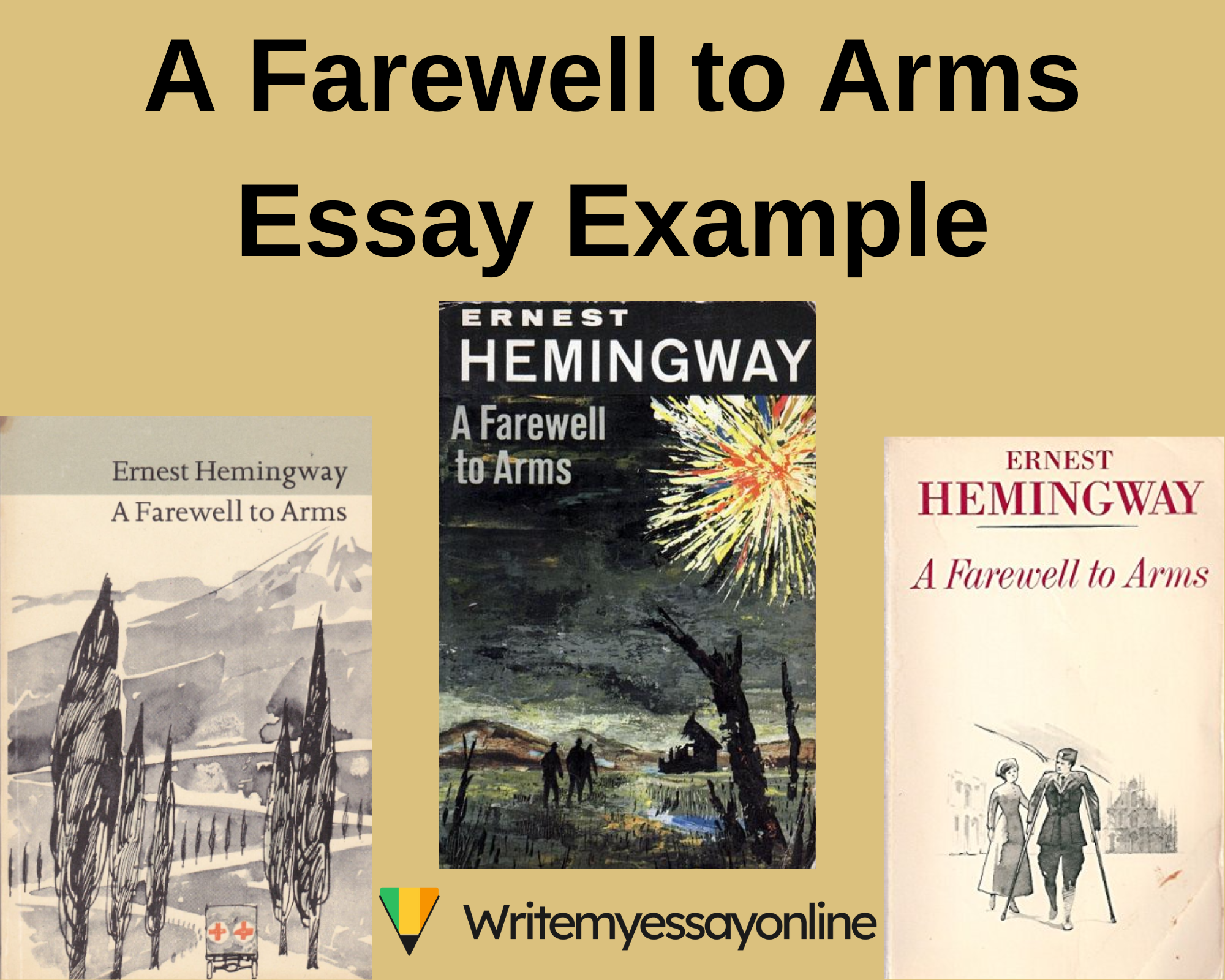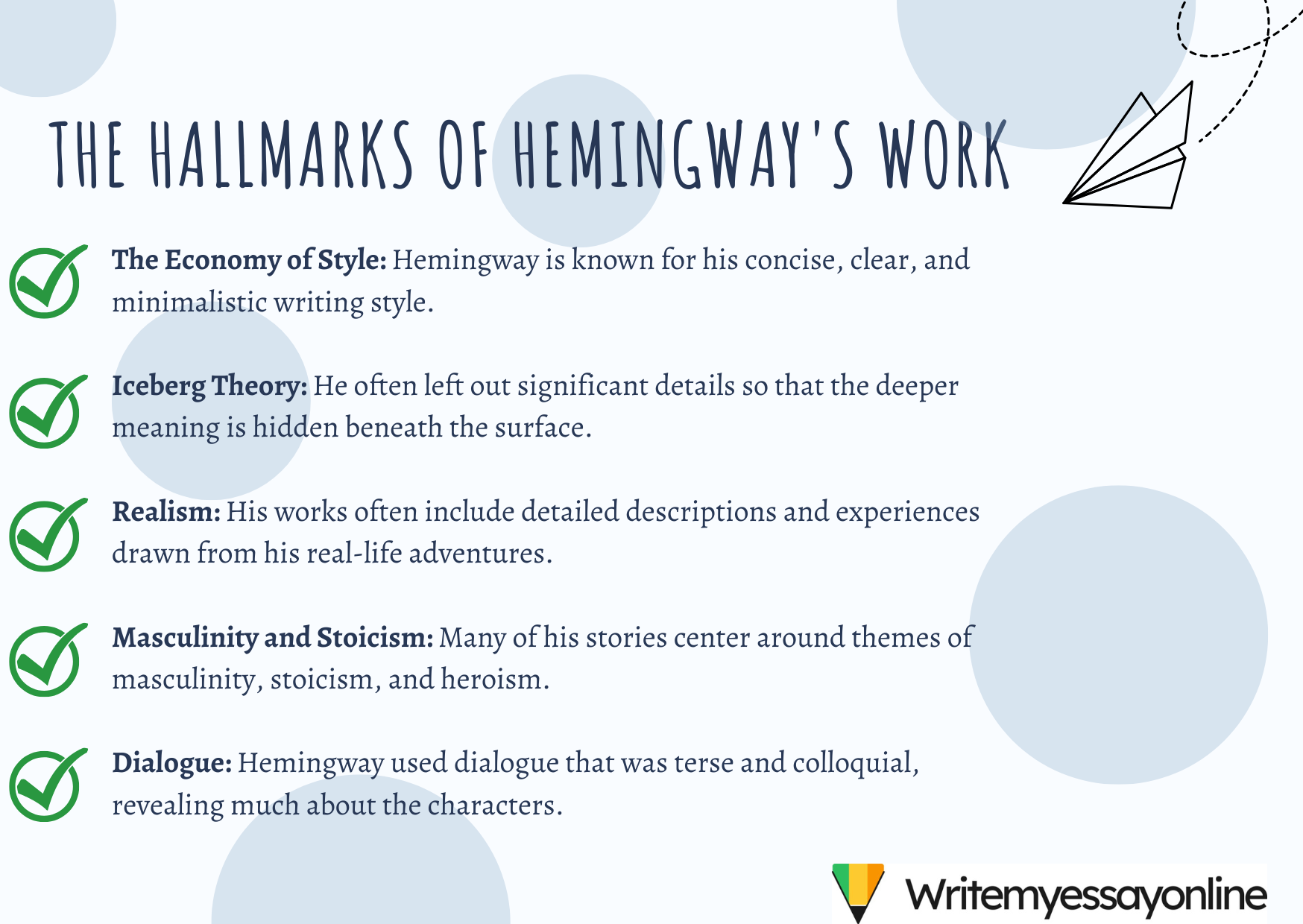We have prepared a good example of A Farewell to Arms essay for you. In “A Farewell to Arms!” Hemingway first widely uses the keynote. The image of rain, like a monotonously sad melody, accompanies the whole narrative – right up to the last page, where the main character of the novel Henry after the death of Katherine goes to his hotel in the rain. “Key word” of the novel as a whole, a lot contributes to the creation of the necessary tonality.
The image of rain is used to express many shades of the same dominant mood.”In the rain” the first chapter ends, in the rain, a retreat under Caporetto takes place. Katherine is afraid of the rain, sees herself dead in the rain, dies in the rain. Undoubtedly, rain is used in the novel as a symbol, but a symbol of realism, having a specific emotional purpose. Seeking to evoke a certain emotional reaction of the reader, he uses those tools that he considers to be the best, and uses them realistically.
A Farewell to Arms Essay Example
The following A Farewell to Arms essay is a good example of how literature papers should be written.
What is the role of rain in A Farewell to Arms? Is Hemingway trying to tell “how the weather was”? Or is it symbolic?
The study of the symbolic meaning of the literary works offers the opportunity to analyze and understand the ideas and thoughts of the author. Hemingway’s A Farewell To Arms has various symbols. The rain is the most significant among them because it concerns the theme of the detrimental effect of war on humans. The rain plays a vital role in A Farewell To Arms because it is a symbol of death, disease, defeat, and suffering.
A Farewell To Arms is a novel covering the themes of war and love. The book introduces the story of an American paramedic, Frederic Henry, who serves in an Italian army and falls in love with the British nurse, Catherine. The presentation of the development of the relationship is connected to the course of the First World War. The ironic depiction of the disillusionment and disappointment in the heroic and glorious image of war is supported by the introduction of the symbol of rain in the novel. The rain is not merely a condition of the weather but the representation of the image of disillusionment and suffering. “The rain in this novel is developed as a symbol of death” (Al-Fahdawi 113). Throughout the story, the rain accompanies such miseries as death, disease, defeat, and suffering; thus, helping the author to reveal the unvarnished truth about the brutality of war.
From the beginning of the story, the author provides the idea about the rain as the symbol of death and decay. The writer explains that everything became “wet and brown and dead with the autumn” (Hemingway 9). The rain is a constant companion of autumn, which is considered the allegory of decay and fading. Therefore, the association of rain with autumn is not accidental because it helps the author to introduce the readers to an idea about the destructive character of the rain. Furthermore, in the first chapter, Hemingway explains that rain brings cholera. Consequently, this fact associates the rain with the disease and helps the readers to notice the attitude towards the wet weather.
Catherine’s attitude towards the rain represents the idea of the fearsome and menacing qualities of war. One of the most prominent scenes in the story is the moment when Catherine explains her fear of the rain. “I’ve always been afraid of the rain”(Hemingway 118). She acknowledges that she has some foreboding regarding the connections between rain and death because she assumes that they may die in the rain. This part of the story is the most obvious evidence of the symbolic meaning of the rain because it explains the perception of this condition of the weather by the characters of the story.
The rain is a constant companion of various scenes in the novel, which are associated with the disaster or suffering. It is raining when Frederic is diagnosed with jaundice, which means that the disease emphasizes the detrimental influence of the rain on the perception of the events. It also rains when Frederic learns about his arrest. Furthermore, the rain accompanies the characters during their escape to Switzerland, which leads to Catherine’s death. The readers start to have threatening and disturbing feelings when they encounter the refers to the rainy weather. Thus, the subconscious understanding of the fearsome characteristics of the rain begins to emerge throughout the story.
The disastrous character of the rain is also emphasized by its comparison with the sunny and snowy weather. The warm and hospitable weather of Milan gives hope to the characters and accompanies the personages during their enjoyable time and romantic meetings. Also, the symbol of snow can be compared to rain. In particular, snow is a symbol of hope and relief. The snow is mentioned in the scene when the characters hope that the offensive will cease not believing that “they will attack now” (Hemingway 153). Therefore, the sunny and snowy conditions are associated with the hope; thus, emphasizing the opposite meaning of the rain.
Rain falls during the disastrous retreat of the Italian army from Caporetto signifying the meaning of the rain as the defeat and failure. The author describes: “between the gusts of wind and rain we could hear the sound of a great bombardment” (Hemingway 170). Again, Hemingway refers to the weather explaining the course of events, which lead to the retreat and failure of the army. In this chapter, the author presents the depression of Rinaldi caused by the monotonous horror of the war and Frederic’s bitter acknowledgment about the responsibility of the society for the war. Thus, the reflections of the characters during the scenes of warfare support the idea about the detrimental effect of the rain on the emotional and psychological state of the personages.
Finally, the moments connected with the delivery and death of Catherine emphasize the idea about the symbolic meaning of the rain as death. The death of the woman proves that her foreboding has its significance. The presentation of the connections between the fear of the rain as the omen of death and the real death of the woman makes the idea about the rain even more evident and apparent. The rain as a “symbol of disaster” achieves its ultimate detrimental form in the final scenes of the novel (Rama Rao 46). Thus, the rainy weather at the moment when Frederic learns about the death of his beloved woman implies the detrimental features of this symbol.
The frequency of the use of the word rain signifies the importance of this symbol. It would be appropriate to compare the number of words rain used in the novel to determine the significance of the symbol. Particularly, in the first half of the story, the word is applied considerably fewer times than in the second half. It suggests that the sorrowful mood increases and accumulates throughout the scenes of the book. Besides, the final word in the novel is the word “rain.” It emphasizes the significance of this symbol to the development of the themes and ideas of the story.
Their meaning explains the significance of the symbols in the literary works to the development of themes. The rain plays a crucial role in A Farewell To Arms because it is a symbol of death, disease, defeat, and suffering. It is connected to the themes of war and love. The rain accompanies various scenes of the story, which are connected with the sorrowful events. These events include the spread of cholera, Frederic’s disease, the disastrous retreat of the army, delivery, and death of Catherine. Also, the symbol of rain can be contrasted with the meaning of the sun and snow as the symbols of hope and relief. The story’s final word is also “rain” signifying the importance of the symbol.
Works Cited
Al-Fahdawi, Muhammad Dera Farhan. “Ernest Hemingway’S A Farewell To Arms: A Critical Study Of War And Its Negative Impact From An Ironic Perspective.” International Journal Of English Literature And Social Sciences, vol 2, no. 4, 2017, pp. 111-115.
Hemingway, Ernest. A Farewell to Arms. New York, Charles Scribner’s Sons, 1929.
Rama Rao, P. G. Ernest Hemingway’s A Farewell To Arms. New Delhi, Atlantic Publishers & Distributors, 2007.
P.S. There are many aspects to consider when writing academic papers. You need a lot of skills to write an essay your teacher will appreciate. If you need help, we are there for you 24/7 providing effective writing assistance.
How to Choose a Topic for a Farewell to Arms Essay
Analyze the context of Farewell to Arms by Ernest Hemingway – consider its genre, era, themes, and characters.
Ask yourself questions about some of the topics which are explored within this novel, such as war, love and romance, masculinity and heroism, etc., and explore how they might be addressed in an essay format.
Brainstorm ideas based on these topics that could be turned into a thesis for your essay – what unique approach could you take?
Write down all possible angles from which you may choose a topic for your paper or research project focusing on this work of literature. Consider asking us, “write my thesis for me,” if you have any trouble.
Narrow your options by taking away ideas that do not support your paper’s purpose effectively enough or have too broad of a scope to develop into something comprehensive in an essay format alone.
Finally, pick one of the topics that will allow you to express yourself best and create a coherent argument through an interpretation supported by facts and examples from Ernest Hemingway’s Farewell to Arms, wherever relevant. Consider hiring essay writers online if you still have trouble choosing a topic.
Hemingway’s Influence on World Literature
Most notably, Hemingway’s works explored themes such as stoicism in the face of tragedy and masculinity during extreme hardship. His Iceberg Theory (in which a story’s true significance is communicated through extensive subtext rather than merely by what is explicitly stated) paved the way for an entire generation of authors seeking to explore their inner psychological conflicts through narrative.
Hemingway’s approach also inspired conceptions of literature that emphasized brevity while exploring deep moral questions. On top of his philosophical contributions to literature, Hemingway most famously revolutionized the aesthetic style that came to be known as “minimalism.”
Through simple premises and shorter sentences over a few paragraphs, Hemingway sought to capture brief moments from life and craft narratives suffused with meaning beneath straightforward surface plots. With this stylistic achievement, many writers learned how they could convey vast landscapes within much smaller constructs that mirrored aspects of life more generally.
In sum, it can be said without exaggeration that Ernest Hemingway was not only one of America’s premier short story novelists but truly one of finest talents when it comes to world literature; his influence continues today in myriad ways expanded towards philosophical and aesthetic levels beyond what was once thought possible before him.
There are countless exciting Hemingway essay topics to choose from. Remember to ask us, “do my essay”, if you still have issues with essay writing.

